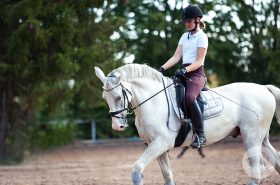If you are a beginner rider, have you ever wondered if your current trainer or farm is the best for you in achieving your goals? Have you questioned when it is time to change instructors so you have the opportunity to grow your skills and advance? Have you created goals for yourself, and will the trainer or farm you currently ride at help you meet your goal? How does your riding school’s lesson program progress students as riders advance their skills? Do students transfer to another teacher, or can students ride with the same trainer as skills advance? Is that important to the rider and their goal? How do you or your child feel about switching coaches after building a solid rapport with the first teacher? What if the student’s goals do not align with how the riding school operates? When beginning lessons, there are many considerations, and awareness of the riders’ goals will help students pick the best trainer or know when it is time to part ways. Let’s discuss a few considerations for finding the best coach, and when ending a student-coach relationship is necessary.
Riding school programs operate differently, so finding a program that works best for you involves doing your homework and awareness of your goals. Riders often pick new farms solely based on conveniences. Some riding schools employ multiple trainers, and students book lessons based on their riding availability. Programs that offer a variety of ride times for students and have numerous instructors simultaneously teaching are great because it allows students flexibility in scheduling. Sometimes riding programs similar to this model have trainers who teach multiple levels, or some instructors will teach specific level riders only, and as students progress they transfer trainers. Both approaches are great depending on what the student prefers. A challenge in this approach might be the student experiences inconsistency in multiple ways, which could create difficulties for students with goals that require a more personalized approach to achieve them.
Students who have goals, which require personalized considerations may benefit from riding at a training farm that has a riding school program additionally. Show and training farms with riding programs often have fewer coaches, which means consistent coaching from the same teacher. A unique aspect of a farm that utilizes this approach is it offers specialized training for riders stepping out of the casual riding school program and advancing into higher levels of training, and great for riders aiming to begin showing. For example, many school programs set a jump height max for their school horses, so students who wish to jump higher eventually must lease or purchase their horse.
Riders should understand differences within the programs they are considering. Awareness is important because the barn the student currently rides at might not be where they continue to ride for years but is a great place to begin their riding career. This helps riders set goals, allow for goal modification, create an action plan, and provide students the opportunity to form a solid rapport with their coach. Numerous factors contribute to riders performing at their personal best.
Having an idea of goals can alleviate students’ anxiety when they wish to part ways with their trainer. Parting with a trainer can be difficult and emotionally upsetting for the student as well as the coach may feel the student is leaving because the student is upset with them. Time, money, and effort building a professional relationship between both parties have formed. For example, if the trainer does not have higher-performing level school horses, and the student states their goal is to jump higher eventually, the coach will understand the separation is not because the student is unhappy with the coach personally, but now the student has different requirements to advance. The coach is aware of the student’s targeted goal from the beginning and the professional relationship is well.
As a new student, it is essential to do your homework and research the farm you consider. Understand their program, requirements, and how they facilitate the students learning. The rider needs to know their goal because if the student and coach are not on the same ‘path,’ then often the lack of communication is where difficulties begin. No one should tell a student what their goal is, but it is the student’s responsibility to know what they want to achieve; otherwise, how can your teacher help you? If the student is not aware of their goal, how can the coach create an action plan and help the student achieve goals? A student doesn’t want to feel like a hamster on a wheel, but awareness of where you want to go is essential.
Do you have riding goals? How do you and your coach create a plan that helps you achieve your goals? Tell us what has worked (or not worked!) best for you in order to achieve your goals!



